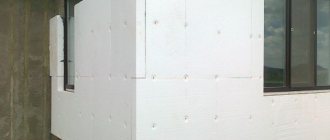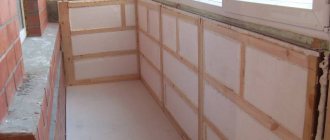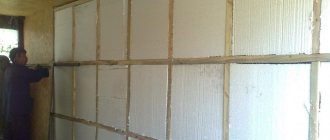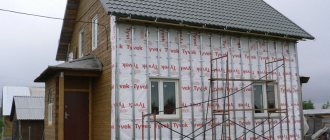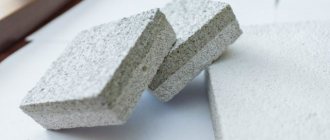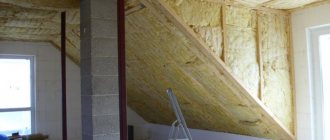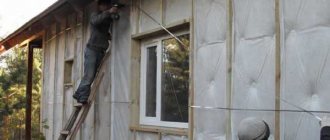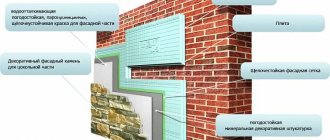In apartments and private houses, designers often use zoning. The living room and kitchen combine well. Two rooms connected to each other look spacious, and this layout will make the space cozy.
You can update the design, implement interesting ideas, or repeat a design seen in a magazine, TV show, or photo on the Internet. The style in the living room-kitchen can be different, and choosing it can turn into a fun experience.
Before combining rooms, designers advise taking into account the basic rules, creating a project, and choosing colors.
Zoning
Designers do not advise giving in to fashion trends and copying design ideas without taking into account dimensions, location and other nuances. Before planning and arranging furniture, every detail is thought through.
There are several simple rules that experts advise you to follow:
- Let the room have natural light. To do this, remove excess walls (except for load-bearing ones).
- If the rooms in the apartment are small (12 sq. m or 16 sq. m), the layout of the kitchen combined with the dining room will be the right solution.
- If the ventilation system is not designed correctly, the smell of food will spread throughout the apartment.
Partitions
The interior of the kitchen and living room begins to be thought out from the junction of the two zones.
- Here are some of the ways and objects that delimit space:
- installation of a bar counter;
- kitchen island;
- big table;
- installation of a low partition.
Designers advise installing a wide counter, since you can sit at it like at a regular table, and high chairs are quite suitable for the whole family.
However, in small rooms (16 sq m), narrow counters are installed. Kitchen islands are convenient to use, but are only suitable for large kitchen-dining rooms (25 sq m or 30 sq m). Capital low partitions are installed only if it has been decided in advance what they will be used for (for example, as a TV stand).
Material advantages
Thermal insulation of a building using polystyrene foam (the second name for polystyrene foam) has the following positive aspects:
- Low cost. Compared to other thermal insulation materials, this one will be inexpensive, and you can buy it in almost any store.
- Good thermal insulation properties. Foam insulation gives the same effect as the popular mineral wool and Penoplex. The thermal conductivity coefficient of all these materials is similar.
- Ease of use. The material is easy to cut. You can work with it without using special tools or protective clothing. In addition, the insulation is easily attached to glue and special fungi.
- Light weight and size. Transporting polystyrene foam will not be a problem. The material is easy to transport independently. This option allows you to reduce insulation costs.
The advantages of insulating a house with polystyrene foam do not end there. The material does not pose a danger to humans. It can be used both inside and outside. But when using it, it is worth remembering the disadvantages. The disadvantages are presented below.
Finishing
If the kitchen combined with the living room has the same floor covering, then there are no special rules for carrying out the work. When combining different materials, take into account in advance where they will be joined.
For example, laminate flooring creates unsightly joints with tiles. The main thing is that the floor is flat without curved joints, as they will be noticeable. Kitchen cabinets that are mounted on the walls should reach the ceilings. In some cases, craftsmen “lower” the ceiling with plasterboard.
Furniture items
A few examples of furnishing a kitchen combined with a living room:
- 1. Sofa. It becomes an object that zones space. The sofa is placed with its back facing the place where food is prepared. In small rooms (less than 20 sq m) a corner is placed, which is placed against a wall installed perpendicular or parallel to the kitchen.
- 2. Set. According to designers, minimalist models without elaborate details look modern. The service, vases or glasses are placed on an open shelf. You can buy a fashionable display case for them. Furniture is placed near the wall. If the space is large (20 sq. m, 25 sq. m or 30 sq. m), then in the central part you can install an island, which also has sections for kitchen appliances.
- 3. Furniture set. The style should be combined with the design of both rooms. In small rooms, a compact table and chairs made of transparent material or painted in light colors look good. You can add a table with a round top to your living room interior. In spacious rooms, the kit is installed near the wall or in the central part. An elongated rectangular dining table would look good here.
Technology 3 construction using foam formwork
Features of the technology
The essence of this technology is that hollow foam blocks are used to build walls. Reinforcement is installed into the space inside the blocks and concrete is poured. The blocks have standard dimensions of 950x250x250 mm.
Thus, at the construction stage, foam plastic acts as formwork, and after the walls are erected, it serves as insulation.
Construction of a house using this technology is carried out as follows:
| Illustrations | Description |
| Construction of the foundation. For such a house, it is best to build a regular strip foundation. It is being built using standard technology. | |
Formwork assembly:
| |
Pouring concrete:
According to this scheme, the walls are erected to the required height. Then the roof is installed and finishing is carried out. |
Advantages and disadvantages
Advantages:
- Strength.
Construction using foam plastic permanent formwork allows you to get a full-fledged monolithic housing that can withstand any load; - Durability.
A house built in this way can last more than 100 years;
- Simplicity and speed of construction.
Compared with conventional formwork, the blocks are installed much easier and faster; - Thermal insulation qualities. Unlike a conventional monolithic structure, the walls of a house built using this technology do not need insulation.
Flaws.
The disadvantage of such construction is its high cost. The blocks alone cost about 1,000 rubles per square meter.
Multi-level floor
To zone the space, craftsmen install floors at different levels. They advise installing a podium to separate the kitchen and dining room. This option is considered one of the most practical because, among other things, the owners have additional free space where they can hide something.
It is convenient to use boxes or crates for this. Wicker baskets will look good. But such space can remain free.
For podiums, reliable materials are selected that can withstand heavy loads. Usually builders make wooden or metal podiums.
However, such a design should not be made if there are small children in the family, since the podium can become an obstacle for him. In addition, various floor coverings can be used. They will zone the space between the living room and the kitchen and protect the podium from damage. For example, tiles are laid in the kitchen area, and laminate flooring in the dining room. The main thing is to choose colors and textures and combine the finishes correctly.
Myth No. 6. The fragility of polystyrene foam
It is too early to say that this material has been tested by time, because its production was mastered only in the 1950s. However, laboratory studies have shown that polystyrene foam boards are designed for 80 conventional years of operation. In addition, it should be remembered that polystyrene foam is a polymer material inert to biological destruction, so it is quite durable. It can have only two “enemies”: UV radiation and mechanical influences. However, you can protect yourself from them by covering polystyrene foam with a reinforcing mesh with plaster, clinker tiles and other facing materials applied on top.
Styles
There are many current trends and design ideas. The kitchen-living room in a modern style looks simple and minimalistic. At the same time, it is not necessary to strictly adhere to any style; you can take its main idea as a basis and cleverly play with it with accessories and other details.
Scandinavian
This style came into fashion several years ago, but still does not lose its relevance. Its practicality and European elegance are well suited for a living room in a city apartment or house. You can add bright accents, for example, textiles of different shades.
The basis for the Scandinavian style is white and gray finishing, wooden details. To decorate the space, pink, blue or ocher elements are suitable.
Technology 1 frame construction
Features of the technology
Frame construction is far from a new technology. However, in our country it has become widespread only in the last two decades.
The essence of this technology is to build a house frame from wooden beams. In this case, the space of the frame is filled with foam plastic. On the outside, such walls are sheathed with OSB boards, and on the inside with plasterboard, clapboard or other finishing material.
Thus, foam plastic in this case serves as a wall filler, responsible for wall insulation and sound insulation.
Advantages and disadvantages
We will not go into details of the frame construction technology itself, since it has already been discussed several times on the pages of our portal. Therefore, further I will only talk about the pros and cons of insulating a frame house with foam plastic.
Advantages:
- Efficiency.
Due to the low thermal conductivity of polystyrene foam, in central Russia a thickness of 150-200 mm of insulation layer is sufficient. The housing will be warm and energy-saving; - Economy.
Foam plastic is one of the cheapest materials that can be used in frame construction;
- Environmental friendliness.
This material is hypoallergenic and does not cause irritation upon contact with the skin, unlike mineral insulation. Therefore, it is comfortable to work with him; - Shape stability.
Polystyrene foam does not shrink, which eliminates the appearance of cold bridges in the walls; - Durability.
If the insulation technology is followed, the material will last more than 50 years.
Flaws:
Zero vapor permeability. For this reason, the walls from the inside need sealed vapor-waterproofing. Otherwise, all the moisture will accumulate in the joints between the wooden frame parts and polystyrene foam, which will lead to rotting of the frame. Water vapor barrier, in turn, turns the home into a sealed “thermos”. Therefore, such buildings require high-quality ventilation;
Fire hazard. Polystyrene foam manufacturers very rarely add fire retardants to their composition. As a result, the material burns well and at the same time releases dangerous toxic substances.
For these reasons, foam plastic is rarely used to insulate a frame-type house. Mineral wool is most often used.
It must be said that instead of polystyrene foam, you can also use penoplex in a frame house. This material is an improved version of polystyrene foam.
Penoplex is more effective in terms of thermal insulation, and is also stronger and more durable. In addition, penoplex usually contains fire retardants, which makes it a low-flammable material.
The disadvantage of penoplex is its low vapor permeability. In addition, the price of penoplex is 2-3 times higher than that of polystyrene foam.
Loft
This year the style remains in demand. It is often used to equip kitchens combined with a living room. This combination gives more free space, which will only emphasize all the details of the loft.
Today, such a definition as “classic style” is used less and less by designers. Loft - any interior design in which various technical elements are not hidden, but emphasized.
For example, stylists play with brickwork, wires or concrete walls. The photographs clearly show how successful it can look like a living room that is combined with a kitchen. For loft, rough and heterogeneous surfaces and rough materials are selected. In apartments decorated in this style, wall lamps are installed. In this case, the light is directed along the walls. Due to this, shadows fall so that uneven surfaces look three-dimensional. At first, loft was viewed with caution, but it quickly became popular. Designers do not hide finishing materials and even fake them. To imitate a concrete surface and smudges, decorative plaster is used.
Insulating the exterior of a house with foam plastic: step-by-step instructions, list of tools
It is better to prepare everything you need in advance so as not to waste time searching for materials later.
What you will need:
- A trowel (trowel) is a polished steel blade.
- Weight with thread.
- Level for defining boundaries.
- Hammer.
- Steel plate with handle.
- Hacksaw.
- Roulette.
- Pencil for marking.
- Electric drill.
- Drills for concrete.
Drive-in dowels
- Bucket for mixing the solution.
- Drill with attachment for stirring dry mixture.
- Fasteners (the length of special dowels is 4-5 cm longer than the width of the sheet).
- Dry adhesive mixture.
- Foam for installation.
Thermal calculation
How to get started with exterior walls
First you need to determine how much insulation is needed for the entire surface of the house facade. The calculation is simple - add up the total area of the external walls (add a little on top in case of fitting errors and at corner joints), buy additional dowels (about 7 pcs.).
You should act according to a clear plan - first clean the slabs and cover all defects, then treat the surface of the slabs with a diluted primer (we wrote about the preparatory work above).
Installation of scaffolding
Preparing the wall surface
Determine where you will start laying the insulation (exterior, window openings or doorways).
Determining the dowel size
Priming the base
We will begin insulating the walls outside with polystyrene foam. Use a plumb line to check the wall for unevenness and differences (you can use a laser level).
Place a dot at the bottom of the blocks and draw a strip for laying the first row of foam. If the walls are curved, then first install aluminum support profiles and attach the sheets to them.
If the surface of the foundation is flat, then the foam is laid directly on the foundation that has been cleaned and treated with a solution.
Enlargement of the base part
Measuring base deviation using a level
Adhesive “Moment Montazh” for gluing foam tiles together
The most popular glue for joining pieces of foam plastic is “Moment Montazh”.
Before purchasing, you need to understand that, depending on the composition, the adhesive substance can ruin the structure of the material (the type of solvent affects the destruction).
The glue is applied to the material in a thin, serpentine strip, 2 cm from the edge.
Installation of beacons for the first row of polystyrene foam boards
There are several types of glue: in the form of regular glue in a tube (acrylic), liquid nails with synthetic resins (on the “MP” tube), and nails with a water-polyacrylate dispersion (on the o tube).
Glue with synthetic resins is very flammable, but very durable and moisture resistant.
MV glue is suitable for gluing baguettes, baseboards, and other interior decorative works.
Kneading the adhesive mixture
Preparation of the required form of polystyrene foam
Technology of external wall insulation with foam plastic: gluing polystyrene
Before you start gluing sheets of foam plastic and applying them to the outer surface, you need to wait until the walls dry out after treating the house (it is recommended to wait at least 30 days for moisture and other substances to evaporate).
The next step is to prepare glue from the dry mixture. The more defects there are on the wall, the more solution will be needed (this is why it is recommended to cover up all the unevenness first, because even remaining dust can increase glue consumption).
Increasing the height of the plinth
Consumption also depends on the method of applying the adhesive mixture - for some, one layer is enough, while for others, two are applied.
The characteristics, proportions and composition are indicated on the bag of glue. Facade adhesive not only performs its main function, but also smooths out small roughnesses and creates additional insulation for walls.
Cord tension for the first row of slabs
Following the instructions on the package, pour the mixture into a bucket, fill it with water, and stir with a drill and attachment (turn speed should be low).
The result will be a waterproof and frost-resistant mass, which, after hardening, will turn into a protective film.
Make cuts in the slabs for the first row with a fine-toothed knife. If you have a nichrome thread, it is better to use it (heat it before use). Nichrome thread is a wire made of chromium and nickel alloys, which, when heated, can withstand temperatures up to 1300°C.
The advantages of using thread are that polystyrene is cut perfectly evenly and does not crumble.
Control gluing
It is better to cut polystyrene foam for insulating walls outside on some flat surface, and not on the ground. When the boards are prepared, you can proceed to lubrication with glue.
If the material is extruded polystyrene foam, then you need to make roughness on the foam using a “spiky” roller, otherwise the layer will fall off the wall.
Using light pressure with a trowel, apply glue to the surface of the foam until you get a layer at least 25 mm thick. It is better to apply the mixture in thin strips, starting from the corners and further along the perimeter. First apply one thin layer, and only then a second, more voluminous one. Make sure that the mixture does not lie on the ends of the layer.
Place glue dots (2-3 pieces) in the middle of the block, lean the foam against the wall - this way you can determine the proportion of the occupied area of the adhesive mixture.
Installation of the first slab
Gear method
The adhesive contact should not exceed 60% of the total adhesive area (maybe less, depending on the thickness of the layer). Our goal is to make the surface of the facade as smooth as possible; the dry mixture provides additional leveling.
Sometimes the adhesive is applied to a cinder block wall rather than foam (if the wall is very uneven).
Successful technology for insulating walls with foam plastic from the outside with your own hands depends on compliance with certain rules.
One of the most important things is that the seams of the bottom and top rows do not coincide when laying. To do this, you need to lay the slabs so that the upper layer moves away from the lower one. Draw the location of the top and bottom rows on the wall in advance. If the distance is less than 15 cm, the seams will allow cold to pass through.
Installing the slab on the plinth
When everything is ready, glue the first block of polystyrene foam in the marked place, using a thread or level, check whether the plate is level. Do not forget to place pieces of foam under the bottom layer, which will support the block until it “sets.”
Having glued the first layer of insulation, glue the remaining blocks in the first row in the same way (if the wall is smooth, then use dowels, and for reliability, glue too).
Then proceed to install the second row. Press the material tightly against each other, making sure that there are no gaps between the layers. Lubricate small gaps with mounting adhesive (you can use foam) or fill them with pieces that remain after cutting the foam.
Once the mounting adhesive has dried, cut off the excess with a hacksaw.
If the surface of the blocks is not completely smooth, sand it with a plaster float. Insulation of walls with foam plastic is not complete without final sanding of the joints.
Control by building level and cord
Removing beacons and removing glue
Insulation of corners
To insulate a corner of a house with polystyrene foam, one block must protrude beyond the boundaries of the wall at one corner and coincide with the thickness of the material glued on the other side. The arrangement of the blocks changes - the squares are glued in the opposite, checkerboard order. Excess material is carefully cut off and the joints are sanded.
Glue the blocks on the inner corners. Before doing this, make markings on the foam in advance.
The corner protruding outside the house does not need to be lubricated with glue; apply the mixture only to that part of the slab that will be glued to the corner of the wall; the second part beyond the border should remain clean.
Formation of external and internal corners of the first row
Installing a corner slab
Place the foam plastic against the surface of the facade, check with a level whether the layer lies evenly; if not, then level the block.
Prepare the next corner - make a mark according to the size of the first corner, cut off the excess, apply glue and lean it against the wall, tightly connecting it with the previous part.
After joining the parts, remove the excess with a saw. If everything is correct, you will get an even angle. Fill the gaps with pieces from the remains of the sheet (smear with glue and insert inside).
All corners of the building are glued in the same way.
Inserting a slab into a corner
Complete installation of the first row
Insulation of window frames, doorways and walls
It is recommended to begin work on window insulation after installing the window sill, slopes and other components of the window.
Do not forget that the thickness of the foam and decorative trim will be impressive - the main thing here is that the dimensions of the window sill and slopes match, and do not turn out to be too small after installing the insulation (which is also possible).
What should be the dimensions:
- Window sill: protrusion beyond the wall no more than 4 cm.
- Slopes: protrusion no more than 1 cm (insulation is not taken into account).
- Casting (strip of galvanized steel): pitch 20 cm.
If the insulation is 6 cm thick, then the depth of the window sill should be 10 cm. All gaps when installing the window sill must be filled (use polyurethane foam or insulation).
Insulating the house with polystyrene foam from the outside begins with the slopes (they should protrude 1 cm without insulation). The insulation should be 3 cm thinner (otherwise it will simply “crawl” onto the glass).
Installation of a window unit
Installation of façade profiles for windows
Remove the protective shell (film), treat the window frame with a degreaser, glue the profile onto the window frame, apply an adhesive solution around the perimeter (width no more than 9-10 mm).
Then a fiberglass mesh is pressed against the opening, the second half of which is pressed into a thin strip of glue on the wall, and then a second layer of adhesive solution is applied to it.
The next step is preparation, cutting.
Foam for insulating the area above the window frame often has a more curved shape, so a lot depends on the experience of the builder. When installing the form, do not forget about the drain - if it is not there, rainwater will penetrate into the house.
To prevent this from happening, attach the blocks with a slight slope, then there will be no problems with installing the drain.
Installing an L-shaped window insert
Cutting slabs with heated wire
Doorway
Insulation of doorways with polystyrene foam should be done taking into account the space - if the calculation is incorrect, the door may jam or not open at all.
The door can be installed flush with the main wall. Then it will be inside the foam (“recessed” inside), but for normal opening you will have to file the foam blocks along the edges. If this is not done, the door will constantly touch the ledge. As a result, both the door and the layers will be damaged.
Another way: installing the door using special fasteners and supports (structural profile of “U”-shaped elements). Then the level of the outer layer of insulation and the door will be the same.
After installation, the fasteners are visible from the side on the cinder blocks, and the channels are installed under the door instead of the plinth.
Door slopes
Instructions for insulating a doorway
Before starting work, make markings on the slabs and file all uneven edges. You can use a construction knife to make the cut. If there is no door frame, install it and treat it with a low-grease solution.
Prepare the profiles (the angles of each profile are no more than 40°). Profiles are necessary for additional thermal insulation.
Installation of facade profiles for doors
Secure the profiles on each side. They should fit snugly into the opening (don't forget to remove the protective adhesive strips). Make sure that the corner cuts fit snugly against each other.
The next step is to attach fiberglass mesh strips to the wall. Cut the mesh from the roll - the width should be the same as that of the insulation (add another 10 cm to secure it).
Gluing additional fiberglass mesh
Apply a bead of adhesive to the wall, carefully press the mesh against the doorway and press the edge of the protruding mesh into the adhesive.
Once again, lubricate the pressed mesh with adhesive solution around the perimeter so that it is not visible.
In this way, stretch the mesh on all sides of the doorway.
Then glue the foam cut off at the edges.
It’s up to you to decide which method to choose—internal installation or on the edge. If you decide to “recess” the layer inside the doorway, do not forget to seal the resulting cracks with pieces of material.
Installation of L-shaped slabs
Installation of fungi
When the external insulation of the walls with polystyrene foam is completed, you need to wait a few days (3-4) until the adhesive solution dries, and only then start fixing the sheets.
For final fastening of façade foam plastic, disc-shaped dowels (plastic mushrooms) are usually used. The difference from conventional fastening dowels is the wide cap that holds the fiber insulation.
Plastic mushrooms are made from polypropylene, polyamide or nylon. The fungus should be 10 cm longer than the width of the insulation. One block will require at least 5 dowels (1 in the center, 4 in the corners).
Installation of dowels
Hammering a dowel with a hammer
Drill a hole in the wall with a drill, insert a dowel and hammer it until it stops. The hat should fit tightly to the foam. If this does not happen, remove the dowel and deepen the hole a little more. To reduce glue consumption, the cap needs to be deepened into the foam by 1 mm.
It is more difficult to drive a dowel into extruded polystyrene foam than into polystyrene foam.
If the fungi do not want to clog, then you need to change the worn-out drill. In some cases, spacers (dowel legs that are inserted into the caps) are twisted by hand.
The cap on the surface can be “recessed” inside the foam by cutting out a recess in advance and covering the caps with a cut out circle of foam after installation. It is believed that additional insulation minimizes the penetration of cold into the cracks. But you don’t see such work often.
Installing dowels over the entire surface
Calculation per 1 sq.m
Sealing joints and fungi
Go around the entire perimeter of the blocks with a special grater - this will remove all the rough edges that were missed during work. Cut off the protruding edges with a knife.
It is not possible to clean extruded polystyrene foam with a float - it is harder, and the excess can only be cut off with a construction knife.
If cleaning is not done at all, more materials will be wasted during final finishing.
Seam filling
Cutting off excess
Cover the seams and caps with glue (if they are not covered with foam), level the surface with a trowel.
Wait at least 6 hours until the solution dries, and once again go over the surface of the blocks with a float (or a piece of sandpaper). The goal is to make the insulation perfectly smooth.
Checking for unevenness
Grinding with graters
Neoclassical
Even popular music has echoes of ancient motifs. The same can be said about the design, in which classic details are framed in a fashionable design.
This style is characterized by symmetrical lines, framed mirrors, arched openings, and antique accents. All this is complemented by fashionable finishing materials and accessories. Neoclassicism combines sleek modern details with traditional combinations.
Provence
The name of this destination comes from a region in the south of France. Even a small kitchen-living room, the decor of which was inspired by French aesthetics, will be filled with warmth and comfort.
The main thing is that it has a lot of daylight, textiles with romantic prints, and floral patterns. The dining room in the Provence style is designed in pastel shades. Furniture items can be vintage or artificially aged. Plain walls will contrast with large checkered curtains. The door in the kitchen area set is sometimes replaced with curtains made from the same material as the tablecloth. A good addition would be vases and figurines, clay pots, forged metal parts and ribbons.
Significant disadvantages of insulation
Despite the fact that the material has much fewer disadvantages than advantages, in some cases they become the key reason for refusing to use it.
As it turns out, plastic not only has advantages, and all the disadvantages of EPS are also related to the fact that it is of “polyethylene nature.”
The main disadvantages of extruded polystyrene foam are:
- Poor sound insulation. The material is able to slightly muffle sound waves, but it is not able to absorb them completely, nor can it reflect them.
- Sensitivity to ultraviolet radiation. Under direct sunlight, without specially hiding materials, for example, plaster and other finishes that, among other things, serve as protection, the EPS is destroyed.
- Low vapor permeability. In some cases this can be a plus. But not in all of them. Therefore, homes insulated with extruded polystyrene foam require impeccably installed and effective ventilation. Otherwise, condensation will accumulate in the walls, which will contribute to their destruction.
- Low environmental friendliness of the material. No matter how manufacturers of polystyrene foam protect their product, plastic always remains plastic. Even if it is porous, it will still decompose much longer than any non-synthetic substances.
- The high cost of this type of insulation also makes some people think. Moreover, the harder and denser its variety, the more expensive it is.
Separately, I would like to point out that, for obvious reasons, this material is very susceptible to attacks from rodents.
If there is open access to the EPS insulation layer, mice and rats make whole labyrinths of passages in it and even make their nests in them.
Therefore, it is advisable to carefully seal the layers of insulation with such finishing materials that rodents will not be able to get through to the coveted layer of polystyrene foam.
But the main disadvantage of this type of material is the low degree of fire resistance. As soon as the edge of the stove catches fire, the flame instantly eats it completely. Moreover, combustion is accompanied by the release of highly toxic substances into the atmosphere - phenols, which can cause no less dangerous harm to the lungs than the high temperature itself.
Ordinary extruded polystyrene foam can catch fire, depending on prevailing third-party factors, at temperatures from 250 to 450 degrees Celsius, which is why it should be used for insulation of wooden buildings and structures with the greatest caution. In such cases, experts advise purchasing EPS, flavored with special fire-resistant additives during the production process.
In such cases, experts advise purchasing EPS, flavored with special fire-resistant additives during the production process.
